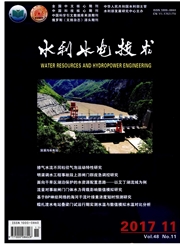

 中文摘要:
中文摘要:
通过支持向量机与相空间重构、小波分析、粒子群算法等的组合应用,充分考虑大坝原型监测数据特征,开展了大坝变形性态预测模型研究。为提升模型的抗噪能性,首先利用小波分析工具对监测数据序列进行时频分解,对分解所得的高频子序列实施阈值去噪处理;进而在借助混沌相空间重构技术,计算各子序列延迟时间与嵌入维数的基础上,重构各子序列的相空间。依据去噪和重构后的变形子序列,建立大坝变形性态支持向量机预测模型。考虑到支持向量机惩罚因子与核函数参数对模型预测精度影响显著的特点,引入粒子群算法,并通过支持向量机的参数寻优,进一步提高了模型的预测精度。工程实例分析表明,相空间重构的大坝变形性态小波支持向量机预测模型具有较强的抗噪和泛化能力,且能够更好地辨识蕴含于大坝原型监测数据中的时频非线性特征,更利于大坝变形性态的精准预测。
 英文摘要:
英文摘要:
Through the composite application of the reconstruction of support vector machine with phase space, wavelet analysis, particle swarm optimization, etc. , the study on the prediction model for dam deformation behavior is carried out under the full consideration of the characteristics of dam prototype monitoring data. In order to enhance the anti-noise property of the model, the wavelet analysis tool is applied to make the time-frequency decomposition for the monitoring data sequence at first, so as to implement the anti-noise treatment for the high frequency sub-sequences obtained from the decomposition, and then, the phase spaces of all the sub-sequences are reconstructed on the basis of calculating the delay-time and the embedding dimension by means of the technique of chaotic phase space reconstruction. In accordance with the deformation sub-sequences after anti-noise and reconstruction, the support vector machine prediction model for dam deformation behavior is established. Moreover, the method of particle swarm optimization is introduced in under the consideratin of the significant features of the impacts from the penalty factors of the support vector machine and the parameters of kernel functions on the prediction accuracy of the model, while the prediction accuracy is further enhanced through the parameter optimizing of the support vector machine. The analysis made on actual engineering case shows that phase space reconstruction-based wavelet support vector machine prediction model for dam defromation behavior not only has strong anti-noise capacity and the relevant generalization ability, but also can more satis- factorily identify the non-linear characteristics of time-frequency contained in the dam prototype monitoring data, thus is more fa- vorable for the accurate prediction of dam deformation behavior.
 同期刊论文项目
同期刊论文项目
 同项目期刊论文
同项目期刊论文
 期刊信息
期刊信息
